Color stranding
When knitting with two or
more colors wherein the distance between color
changes is short, letting the unused yarn be
carried along across the wrong side is called
color stranding. Color stranding creates
a fabric that is -- in essence - two layers thick.
The knitting creates one layer and the “floats”
-- the strands being carried along the wrong
side of the work -- creating the second layer...
which is probably why it's come to be associated
with areas known for cold weather -- Norway,
Fair Isle, Iceland and the Andes for example.
Another type of color work
in knitting is intarsia. In intarsia,
the different colors of yarn are wound on bobbins
-- one bobbin per color rather than being carried
along on the back of the work. (Think Kaffe
Fassett.) Intarsia is best for larger blocks
of color (we'll discuss why a little later)
while color stranding is used for smaller, repetitive
patterns.
Side note: Think Fair Isle
and Color Stranding are synonymous? Not
so!
The first step in doing color
stranding is figuring out how you want to hold
the yarns.
If you hold the working yarn
in your right hand, you'll simply hold both
yarns in your right hand and simply knit with
the appropriate color as you come to it...
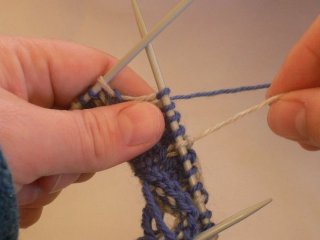
If you normally hold the working
yarn in your left hand, there are a couple of
ways of holding the yarn so you can pick up
the color you want to use. Either with one color
over the index finger and another over the middle
finger...
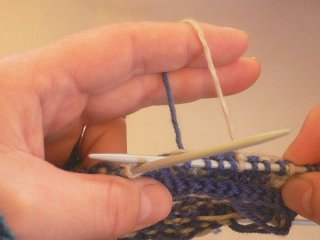
Or with both colors over the
index finger...
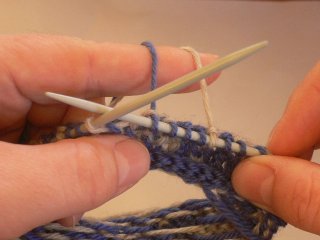
According to my source (on
the actual Fair Isle!) this last way is how
they actually do it on (the real live!) Fair
Isle. If that's the way they do it, I've got
to endorse it as a very good way of doing it
indeed. You might find it a bit tricky keeping
the yarns separate... fortunately there is a
device called a "Knitting Thimble"
or Strickfingerhut which is a guide for
holding the yarn over your left index finger.
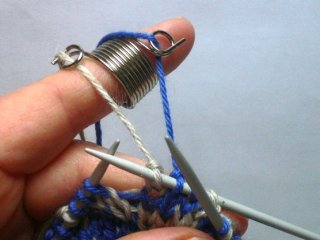
I -- however -- have not quite
mastered the use of it.
When I first learned to knit
I learned to throw the yarn, holding it in my
right hand -- what's known as "English"
knitting. After investigating a bit, I decided
I rather wanted to hold the yarn in my left
hand -- so called "Continental" knitting.
Being able to knit both ways, I do my color
stranding by holding one color in each hand
-- mostly because Elizabeth Zimmerman recommends
it in Knitting Without Tears. More precisely,
I hold the main color in my faster, left hand
and the contrast color in my weaker, right hand.
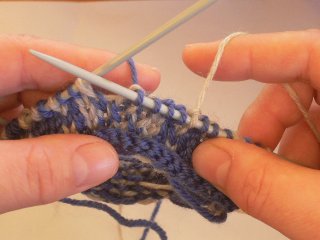
The most important thing about
color stranding is having the yarn carried across
the back of the work at the same tension as
the knitting.
If your floats are too loose
the stitches will elongate and you'll be catching
your fingers in the strands whenever you pull
the sweater over your head or the mitten over
your hand.
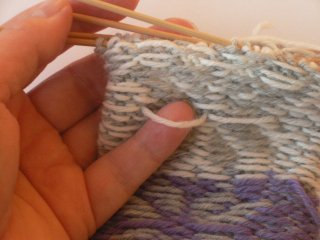
As you float the yarn along
the wrong side of the work, keep the stitches
on the right hand needle spaced out enough that
the yarn floats are at approximately the same
tension as the knitting.
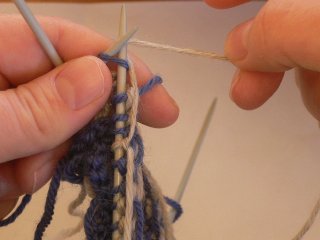
You want for the gauge over
color work to be approximately the same as over
stockingette stitch -- even though the fabric
is thicker.
However! Floats that are a
bit too loose are infinitely better than too
tight. If your floats are pulled too tightly
the stitches will be pulled inwards. In the
next picture you can see that the purple yarn
has been stranded too tightly for a few rows,
causing the stitches to "recede".
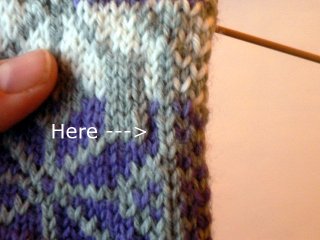
In extreme cases - where the
floats are constantly too tight -- the entire
knitting is puckered and unusable. Also- and
this is an important - It is possible to tighten
loose stranding BUT it is not possible to loosen
tight stranding, so until you've had a bit of
practice, err on the side of looseness.
Hopefully the back of your
work will look something like this...
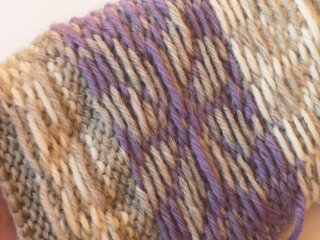
There are several more things
I've learned about color stranding over the
past few years ...
- Knitting circularly with
two colors is FAR easier than knitting flat
and having to purl with two colors. Avoid
purling and color stranding like the plague,
unless you have masochistic tendencies. Read
through your pattern a few times in advance
to check. I'm sure that steeking was invented
to avoiding purling with two colors and you
know it takes a desperate knitter to take
a pair of scissors to her knitting for the
first time ever. (I mean, really. Think about
that!)
- Knitting with TWO colors
is far easier than knitting with MORE THAN
two colors. It's fine for a few rows, but
let's face it -- you only have two hands.
- Wool is ideal for color
work for several reasons. Wool is more flexible
and resilient than, say, cotton and will be
slightly more forgiving of tension errors.
Wool also has a tendency to stick to itself
after it's been blocked and used and washed
a few times which means that even overly long
floats on the wrong side will lie down nicely
after a time. Here is the inside of a pair
of well-worn woolen mittens where the floats
are all stuck together:
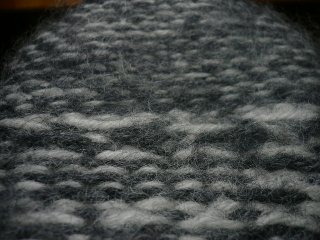
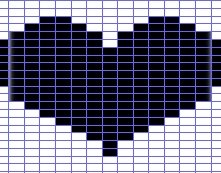
You'll want to look into
using intarsia.
However, if you have a chart
like this one...

where there are no more
than 4 stitches in a row on any one row, color
stranding works very well, indeed.
- There are ways to weave
the yarn in if you need to carry the yarn
over more than 5 -7 stitches. Simply knit
one stitch, then bring the floating yarn over
(or under) the working yarn to catch it in
place.
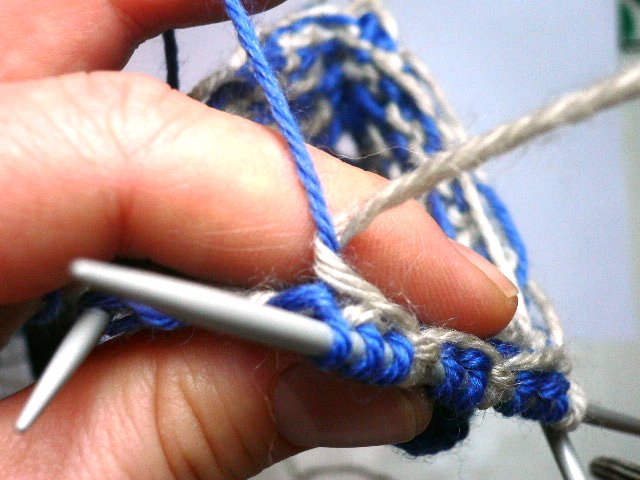
Weaving only needs to be done
if your floats are long, or if you're using
a yarn will not felt down after a time, like
cotton.
Here is an example of extremely
conscientious weaving with cotton yarn:
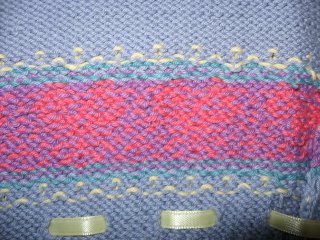
Be aware, however, that weaving
-- especially in colors that contrast sharply
like black and white -- can be visible on the
right side.
As with anything in knitting,
color stranding is simply a matter of practice
and absolutely nothing to feel intimidated about.
If I can do it, you can too!
Want to learn more about Color
Stranding? Try Nanette Blanchard's excellent
booklet: Stranded
Color Knitting
References:
Knitting
Without Tears
Thanks
to:
The Knittyboard Chat Gurus, especially Laura
Prescott for the picture of Extreme Weaving,
and Angela
Wiseman for setting me straight on how they
really do things on Fair Isle. |

